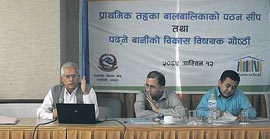Primary-level reading culture: A farfetched dream for Nepal?

The educational curriculum in the country has been anything but effective, with the idea of education being set as either passing the terminal and annual examinations or failing them. The idea of responsibility and achievement of a student, teacher or school is only limited to report cards.
The lack of classroom materials and uniform distribution of textbooks all over the country is another hindrance to making the education system justifiable.
With the above context in mind, Room to Read (RtR), in collaboration with the Curriculum Development Centre, Ministry of Education, conducted a one-day seminar on Promotion of Reading Habits and Skills of Primary Schoolchildren on Friday in which various representatives from the Ministry of Education, non-government organizations, education managers and educationists discussed the need of the promotion of reading habits and skills of primary schoolchildren for lifelong quality education.
According to the National Framework of Child-friendly School for Quality Education approved by the Ministry of Education in 2010, there are five primary indicators of educational institutions which include infrastructure; library; inclusive environment with active participation of student, family and community in all aspects of school policy and management; healthy, gender-responsive environment with security and equality. The situation is such that most schools in rural areas do not have proper infrastructure and basic classroom materials, let alone a library.
It is difficult for such schools to recognize the idea of reading culture amidst the lack of resources. It is no news that most of the teachers from primary to higher secondary level in these schools are not qualified for the job, either. Reading books for students in these schools is a dream too farfetched, especially when even textbooks aren’t easily available there.
“At the end of this seminar, we hope to come up with a provision to provide library in each and every school in the country so that a reading culture is established among the 34,000 primary-level students in Nepal,” said Country Director for Room to Read Ramesh Puri.
Dr. Madhab Prasad Pokharel, Professor of Grammar and Linguistics at Tribhuvan University presented his paper on conceptualization of reading, difficulties and facilitation for developing reading culture of primary schoolchildren focusing on the phonology and phonetics of Nepali language.
“For a beginner of any language, it’s difficult not to apply the grammar of their mother tongue while using words and phrases from the new language. This is a big problem for those studying basic Nepali and Devnagari system in which the sentence structure is, more often than not, complicated,” said Pokharel.
Assistant Director of the Curriculum Development Centre in Bhaktapur, Ganesh Prasad Bhattarai, discussed the provision and practices in national curriculum and textbooks prescribed for various grades and marking system.
The curriculum goes through minor amendments every five years and is revised once in ten years.
“It’s difficult for a six-year-old to concentrate for more than ten minutes. We keep this fact along with the level of understanding and capability of primary-level students in mind while preparing the curriculum,” informed
Bhattarai.
He further informed that the curriculum does not prescribe primary-level students to sit for tests or exams. Instead, teachers can grade the students on their individual progress.
Talking about the efforts put in by the Curriculum Development Centre in enhancing reading culture among young students, Bhattarai said, “We have nine series of recreational textbooks and Nepali dictionary for primary school-level students but the government doesn’t have enough budgets to distribute the books all over the country.” Due to this reason, these books are only available to schools in Kathmandu, and a few schools outside the capital.
Senior Program Coordinator of Education for Save the Children, Laxmi Paudel, shared her experience from her recent visit to Rukum, Rolpa, Doti, Banke, and Bardiya.
“While visiting schools there, I realized that the students of fifth grade couldn’t read the textbooks from the fourth grade,” she said. “They are supposed to have passed the fourth grade and understood the curriculum.”
How can we expect students to take up reading other than textbooks when the teachers aren’t resourceful enough? Where can they learn to pick up the habit of reading?
The seminar aimed at finding answers to these very questions and ended on a note that the participating organizations and the government would utilize each others’ resources to make the education system and the curriculum effective and to enhance the reading culture among students as young as six year old.
source: republica,30 Sept 2012
Posted on: 2012-10-01































